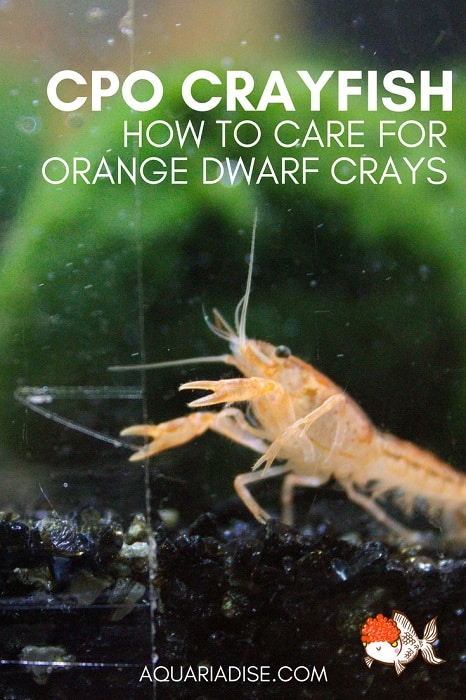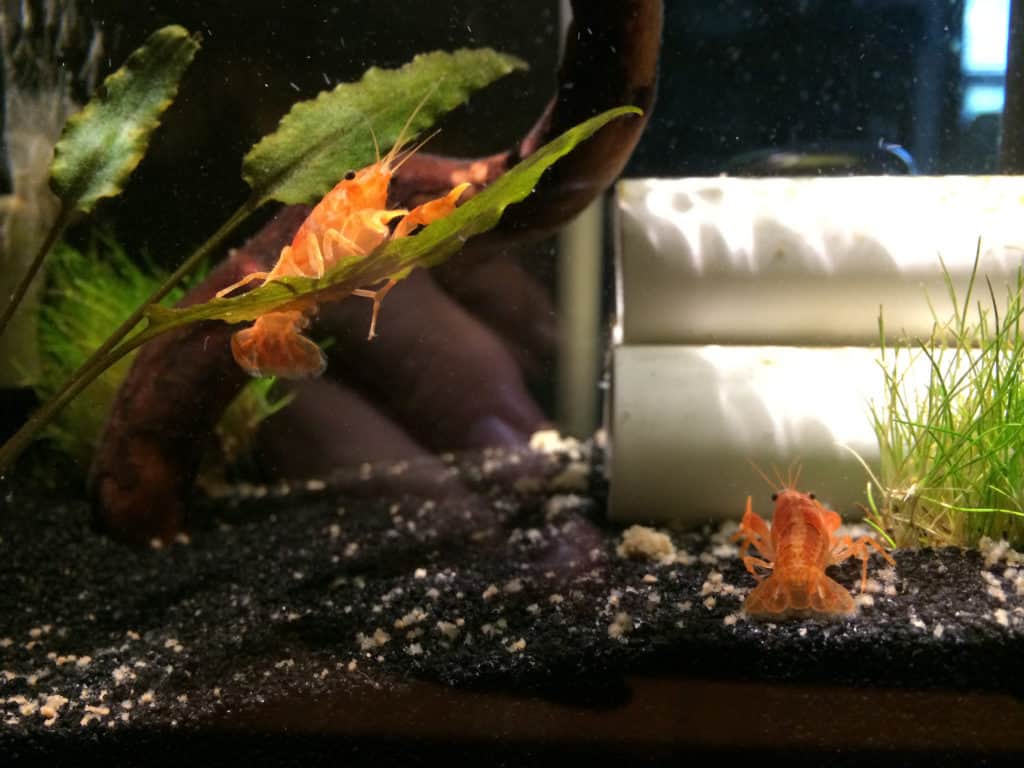Need a pop of color in your nano tank?
The bright orange Cambarellus patzcuarensis, also known as the CPO crayfish, might be the perfect choice. This dwarf crayfish is pretty tiny, but its bright color and feisty personality make it a fun addition to your aquarium.
Keep reading for everything you need to know about CPO crayfish care and keeping this dwarf crayfish in your aquarium!
| Tank size | 8 gal (30 L) minimum |
| Temperament | Peaceful |
| Diet | Omnivore |
| Temperature | 65-78 °F/18-25.5 °C |
| pH | 6.5-8 |
Name
Cambarellus patzcuarensis var. “Orange”, CPO crayfish (abbreviation of scientific name), Mexican dwarf crayfish, dwarf orange crayfish
Cambarellus patzcuarensis natural habitat
CPO crayfish are naturally found in a few locations in Mexico. They actually lend their scientific name from Lake Pátzcuaro, one of the places where natural populations of these crayfish can be found.
Cambarellus patzcuarensis appearance
Although CPO crayfish are naturally brown-grey in color, most specimens you’ll find in the aquarium trade today are selectively bred to be bright orange. As their name suggests these dwarf crayfish are quite tiny, with a maximum size of around 2″/5 cm.
Because of their size sexing these crayfish can be a bit of a challenge, but it can be done if you know what you’re looking for. Try to get a look at the underside of your CPO crayfish: males will have an extra set of modified pleopods under their walking legs, whereas females won’t.
Cambarellus patzcuarensis requirements
Unlike most other crayfish, CPO’s stay small and don’t need a lot of room. You can keep them in aquariums of 8 gallons (30L) and up, which means they’re a great choice for nano setups that are a little too small for most fish. Just make sure the aquarium is filtered and fully cycled before you introduce any livestock. A heater isn’t absolutely necessary unless the ambient temperature tends to be unstable.
One important aspect of CPO crayfish care to keep in mind is that these are prey animals that molt regularly. This means they need plenty of hiding places to retreat to when they feel unsafe or are vulnerable after shedding their exoskeleton. Plenty of decorations are a must! The ideal crayfish tank has tubes or caves, rocks, driftwood and a nice layer of leaf litter. You can also add live plants, as CPO crayfish are too small to damage them like larger crayfish do.

Cambarellus patzcuarensis tankmates
Because CPO crayfish aren’t nearly as aggressive as many of their “cousins” there are plenty of options when it comes to tankmates. Almost all peaceful species that are suitable for your aquarium and like the same water values will work*. Even bottom feeders and fellow dwarf crays should usually be left alone. Just avoid anything that might have an appetite for crayfish, like (dwarf) cichlids and other carnivores.
*Some dwarf shrimp keepers have reported their CPO crayfish attempting to catch shrimp fry. I personally haven’t ever seen this happen, but you might want to skip CPO crays just in case if you keep expensive dwarf shrimp.
Cambarellus patzcuarensis diet
CPO crayfish are omnivorous scavengers, which means they’ll eat pretty much anything they come across. This makes them a great addition to your cleaning crew: they’ll clean up leftover fish foods, dead plant bits and much more. Supplement their diet and make sure they get enough calcium by regularly feeding specialized invert foods like this one.
If you’d like to add some variety to your crays’ diets you can try anything from frozen foods like bloodworms to fresh blanched veggies. Even leaf litter will be appreciated and eaten!
Breeding Cambarellus patzcuarensis
If you have no experience with breeding aquarium crayfish CPO’s are a great starter option because the fry and adults should tolerate each other as long as there are enough hiding places.
All you need to breed your CPO crayfish is a well-decorated aquarium and a healthy pair of crays. If all is well, the crayfish will handle the rest! Pregnant females will carry large amounts of eggs (up to 60, see photo below) between their swimmerettes, constantly supplying them with fresh air and picking off any bad ones. It can take up to five weeks for the fry to hatch and venture out on their own.
CPO crayfish fry don’t pass through a larval stage and can take care of themselves as soon as they leave mom’s protection. You might not see them much at first: they stay in hiding and feed on biofilm and other small bits until they’re large enough to fend for themselves at feeding time.
Buying Cambarellus patzcuarensis
Although you might have some trouble finding wild-colored CPO crayfish, the orange version is widely available. Most aquarium stores carry CPO’s. If yours doesn’t there are also many reputable online sellers out there – you can buy CPO crayfish online at The Shrimp Farm!
If you have any more questions about keeping Cambarellus patzcuarensis (CPO crayfish) or want to share your own experiences with these feisty orange inverts, don’t hesitate to leave a comment below!
Cover photo: IMG_3566 by captkodak






Will they be fine with african dwarf frogs.?
Aren’t the ones who ruin things for others, in this case, the people who get in the way of those who want the crayfish?
Is this in response to the other comments? As long as everyone sticks to their local laws all is well. If you don’t, you risk consequences for the hobby as a whole.
Cool article! However sadly on my local forum this popped up on RSS feed, and despite all crayfish being Illegal we have a gander and enjoy it but there’s a guy that popped up trying to sell his. It’s a shame that people still try and spread illegal inverts. Can spoil the hobby for the rest of us. Nice writup though 🙂
Are you in the UK? Such a pity you can’t keep crays! And as for that person, you’ll always have some people out there who ruin things for others. It happens in fishkeeping, reptile keeping and every other branch of pet keeping . Hope they learnt their lesson!
Nope, South Africa. There’s a lot of those people here, worst thing is it’s often bribery getting these animals into the country.